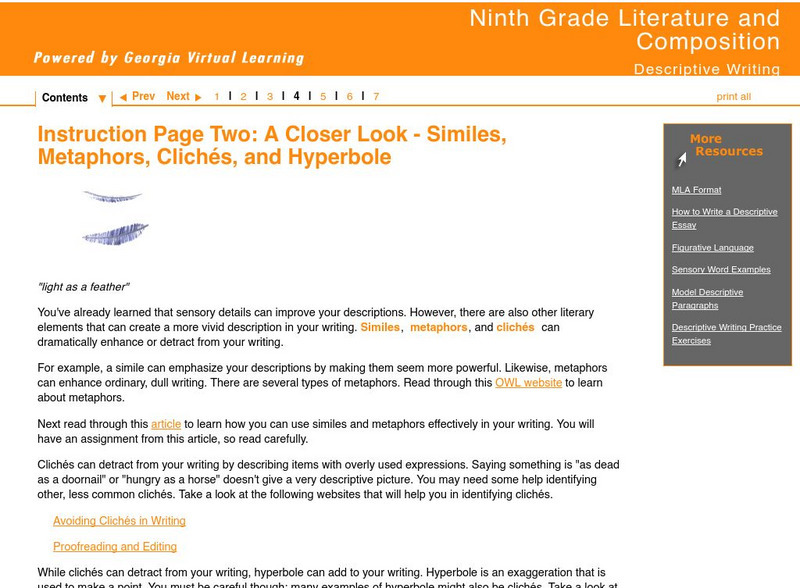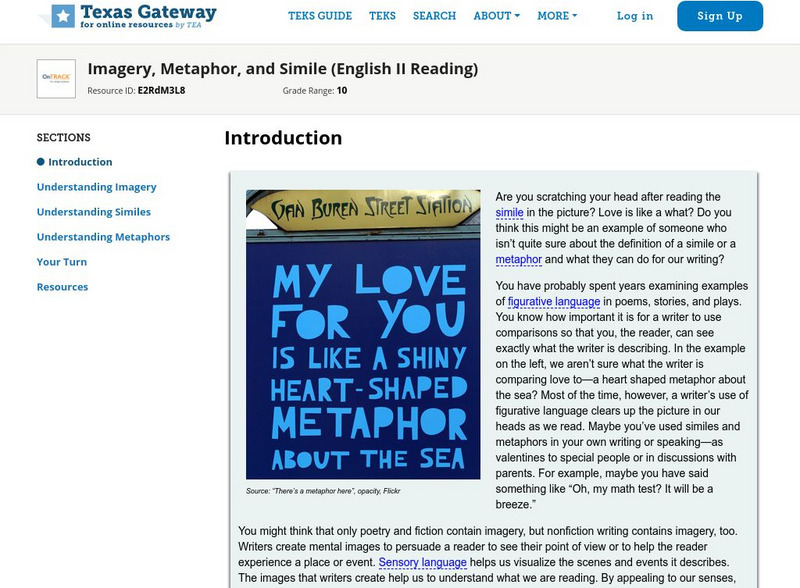Hi, what do you want to do?
Poetry4kids
Simile and Metaphor Lesson Plan
Similes and metaphors are the focus of a poetry lesson complete with two exercises. Scholars read poetry excerpts, underline comparative phrases, then identify whether it contains a simile or metaphor. They then write five...
Soft Schools
Similes and Metaphors
Do your kids a little more practice identifying similes and metaphors? This worksheet can be used as extra practice, for homework, or as part of a group activity
Soft Schools
Rewriting Similes and Metaphors
As part of a study of comparison, kids transform similes into metaphors and metaphors into similes.
Soft Schools
Metaphor and Similes in Literature: A Challenge
After identifying the similes and metaphors in a series of lines from poems, individuals then explain what is being compared and the characteristics the two items share.
Poetry4kids
Creativity Exercise - Describe the Sky
Scholars stretch their writing muscles with an exercise that asks them to describe the sky using similes and metaphors.
K12 Reader
Metaphor and Simile: About You
Class members will be as confident as prize-winning thoroughbreds after completing a worksheet on figurative language. Young writers jot down metaphors and similes for three categories: they way they look, they way...
Novelinks
Tuck Everlasting: Similes, Metaphors, and Personification in Imagery
Poetic language is abundant in Natalie Babbitt's beautiful novel, Tuck Everlasting. Learners note the examples of similes, metaphors, and personification they find as they read, and illustrate how the language creates a sensory...
Curated OER
Poetic Elements Are Fun!
Engage your class in the elements of poetry with a series of lessons and activities. The plans cover simile, metaphor, personification, onomatopoeia, alliteration, and imagery. Learners come up their their own metaphors, identify poetic...
Deer Valley Unified School District
Close Reading: Analyzing Mood and Tone
The AP Literature and Composition exam is all about close reading. Test takers are presented with a passage and asked to analyze how an author uses literary devices to create a desired effect. Prepare your students for the exam with a...
Prestwick House
The House on Mango Street Activity Pack
Enrich a unit on The House on Mango Street by Sandra Cisneros with a selection of related activities. The packet contains nine activities that go from pre-reading through wrapping up the novel. Young readers work on studying...
Winterhill School
Poetry Analysis
Gain greater insight into poems using a poetry analysis worksheet. Here, scholars follow steps and answer questions to dissect any poem. Topics include the poem's meaning, theme, technique, and structure, as well as personal...
Trinity University
I Didn’t Know that was Poetry
Poetry or prose? That is the question facing middle schoolers as they begin a month-long poetry unit by examining the characteristics that differentiate poetry and prose writing. Pupils learn about poetic devices and different types of...
Ereading Worksheets
Figurative Language for Edgar Allen Poe
Are your classes weary of dreary worksheets? Are the learners nearly napping? Thrill them, fill them with delight with an interactive worksheet that asks them to identify the figurative language Edgar Allen Poe uses to add horror and...
Prestwick House
Rhetorical Devices in Political Speeches
Have you ever watched a political speech and felt your heart beat a little faster, and your opinion either solidify or begin to slightly change? Rhetorical devices can be a strong tool in an effective and powerful speech. A short...
Curated OER
Short Poems Are Scary!
What do all those chairs and pencils do in the classroom once everyone leaves? Allow imaginations to run wild with frighteningly short poems!
Curated OER
Ballad
Young balladeers analyze examples of ballads and generate a list of common traits (story, quatrains, rhyme schemes, refrains, etc.), then identify these traits in Robert W. Service's "The Cremation of Sam McGee" and a ballad written by...
E Reading Worksheets
Figurative Language Finder
To demonstrate their understanding of figurative language, middle schoolers use a guided reading worksheet to find examples of figurative language in a text, identify the technique being used, and to explain how they were able...
EngageNY
Grade 11 ELA Module 1: Unit 2, Lesson 15
Scholars continue reading Act 3.1 from Shakespeare's Hamlet, discovering Ophelia's monologue about Hamlet. They complete a Quick Write to analyze Ophelia's perspective of Hamlet and participate in an optional jigsaw activity to explore...
Texas Education Agency
Texas Gateway: Simile and Metaphor (English Iii Reading)
You will be able to identify the similes and metaphors in a text and evaluate their importance to the meaning of the text. W.11-12.2d Lang/Fig/Voc
Georgia Department of Education
Ga Virtual Learning: Descriptive Writing: Similes, Metaphors, Cliches, Hyperbole
This lesson focuses on figurative language used in descriptive writing including similes, metaphors, cliches, hyperbole. It offers multiple links to websites pertaining to figurative language in descriptive and creative writing; an...
PBS
Pbs Learning Media: Literary Elements and Techniques: Figurative Language
Discover how authors use figurative language to enhance their writing and explore the differences between similes and metaphors in this animated video [3:37] from WNET. Discussion questions below help students to further apply their...
Texas Education Agency
Texas Gateway: Literary Text: Imagery, Metaphor, and Simile
Writers use sensory imagery ("smelled the salty air"), similes ("like a strong man playing tug-of-war"), and metaphors ("the waves roaring in my ears") to capture the reader's imagination. In this lesson, you will learn how to identify...
CK-12 Foundation
Ck 12: 6.1 Writing About Literature: Analyzing Prose
[Free Registration/Login may be required to access all resource tools.] Learn to analyze prose by understanding connotation and denotation, identifying metaphors and similes, looking for repetition, and finding imagery in a text.



























